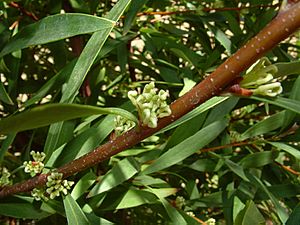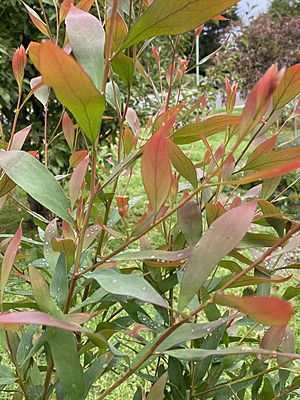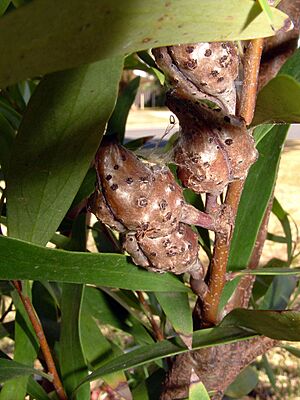Willow-leaved hakea facts for kids
Quick facts for kids Willow-leaved hakea |
|
|---|---|
 |
|
| Scientific classification | |
| Genus: |
Hakea
|
| Species: |
salicifolia
|
 |
|
| Occurrence data from Australasian Virtual Herbarium | |
| Synonyms | |
|
|
The willow-leaved hakea (scientific name: Hakea salicifolia) is a beautiful flowering plant. It grows naturally only in eastern Australia. This plant is a small tree or shrub that grows quickly. It has pretty leaves and creamy white flowers.
Contents
What Does It Look Like?
The willow-leaved hakea is a fast-growing shrub or small tree. It can grow up to 3 to 5 meters (about 10 to 16 feet) tall. Its smaller branches are smooth and have dark red lines. Young shoots might have silky hairs or be smooth.
Its leaves are shaped like narrow ovals. They are widest in the middle and can be up to 12 cm (about 5 inches) long. They are pale green, sometimes with a bluish tint. Young leaves are darker and become smooth quickly.
The flowers grow in clusters. Each cluster has 16 to 28 white or pale yellow flowers. These flowers grow on a short stalk. The fruit of the plant is egg-shaped. It is about 2.3 to 3.5 cm (about 1 to 1.4 inches) long. The fruit has small horns and black, blister-like bumps on its surface.
How It Got Its Name
The willow-leaved hakea was first described in 1800 by a French botanist named Étienne Pierre Ventenat. He first called it Embrothium salicifolium. The plant he studied was grown in a garden from seeds collected near Botany Bay in 1792.
Later, in 1941, an English botanist named Brian Burtt changed its name to Hakea salicifolia. The name salicifolia comes from two Latin words. Salix means "willow," and folium means "leaf." This name describes the plant's leaves, which look like those of a willow tree.
There are two main types (called subspecies) of willow-leaved hakea:
- Hakea salicifolia subsp. salicifolia: This type has wider leaves (more than 7 mm wide). It grows along the coast from Springbrook, Queensland to Jervis Bay, New South Wales.
- Hakea salicifolia subsp. angustifolia: This type has narrower leaves (4 to 7 mm wide). It grows near rivers and streams in the Sydney area, between Hornsby and Helensburgh.
Where Does It Grow?
The willow-leaved hakea is a common plant in eastern Australia. It grows mainly in New South Wales, from Kempsey to the Shoalhaven River. You can also find it in places like Dorrigo, Whian Whian, and the Blue Mountains. It also grows near the border of Queensland and New South Wales. This plant often lives in wet forests, sometimes close to rainforests.
Its Role in Nature
The willow-leaved hakea is a very adaptable plant. It can grow well in many different types of soil and climates. Because it grows so easily, it has become an invasive plant in New Zealand. This means it grows too much there and can take over areas where native plants should be. The New Zealand Department of Conservation lists it as an environmental weed.
In other places, like Tanzania, people have planted it on tea farms. They use it as a wind-break to protect the tea plants from strong winds. It also helps mark the edges of the farms.
See also
 In Spanish: Hakea salicifolia para niños
In Spanish: Hakea salicifolia para niños



